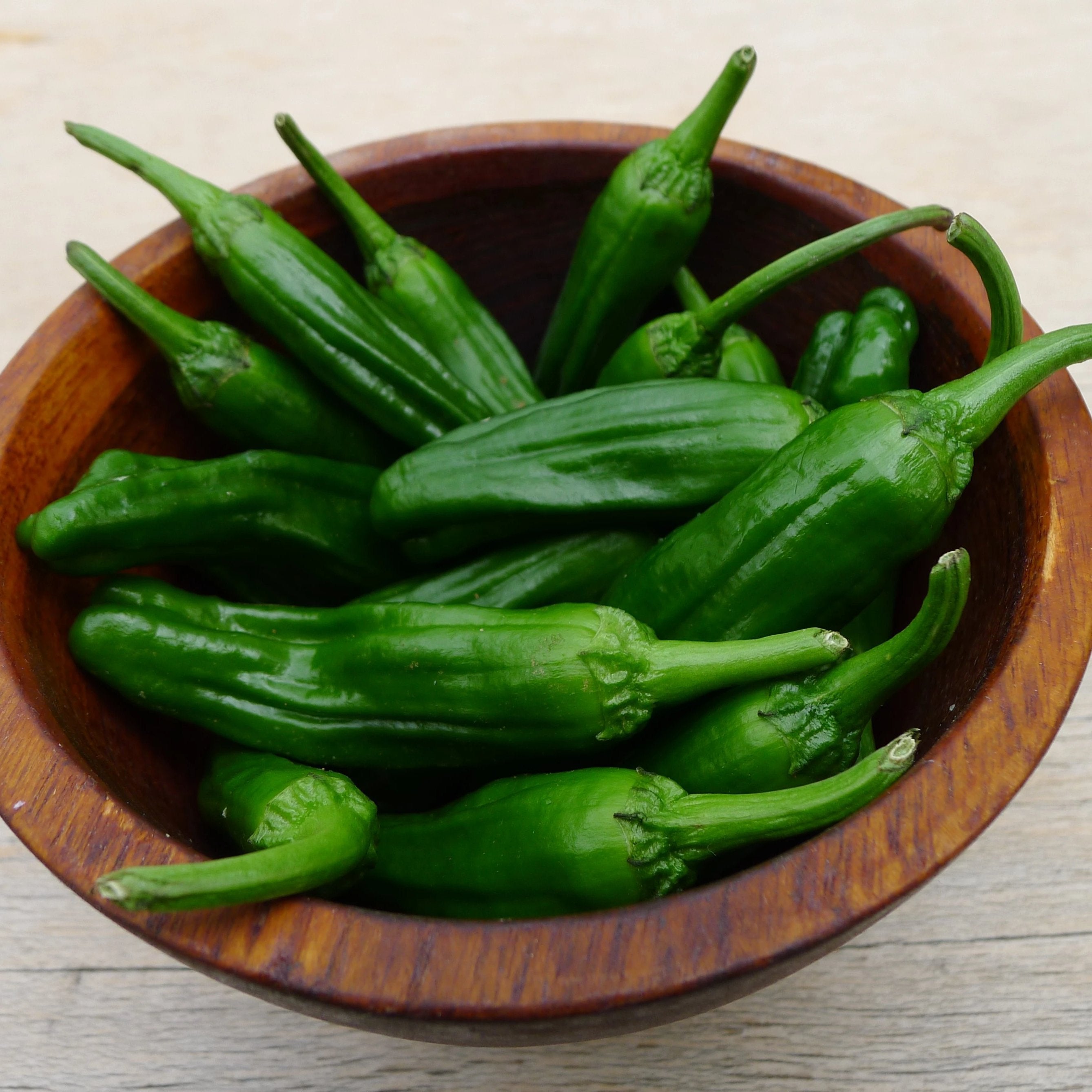Behind the Scenes: The Photoshoots That Brought our Brand Refresh to Life
If you haven’t heard already, we’ve just introduced our brand refresh. Sow True Seed now has a new logo, new website, new seed packets, and all around a fresh new...
Fresh new look, same great seeds - read all about our brand refresh on our blog!
FLASH FREE SHIPPING SALE through 9/1!


Has there been a pepper that has skyrocketed to glory like the Shishito? These delicious green-when-ripe peppers have an unexpectedly complex flavor profile that is both smokey and citrusy. Their flavor becomes more enhanced and wonderful when cooked. Try them grilled! Taste and texture best when harvested at 2-4" long.
Minimum Seeds per Packet: 50
Packet Weight: 0.2g
Planting Season: After Last Frost
Sowing Method: Transplant
Seed Depth: 1/4"
Direct Seed Spacing: N/A
Soil Temperature: 65-85 ℉
Days to Sprout: 10-25
Mature Spacing: 18-24"
Sun Requirement: Full Sun
Frost Tolerance: Frost Sensitive
Days to Harvest: 90 from Transplant
Start your pepper seeds indoors eight to 12 weeks before your last frost date. This is a long season, tropical crop that will not tolerate frost at all and needs a long, warm season to mature. Sow seeds two to three seeds ¼” deep in seed starting containers. Cover with soil and pat down lightly to ensure adequate seed to soil contact. Keep seedlings well-watered until germination and throughout their growth. We recommend watering twice a day but ensuring the soil is not sopping wet. Pepper seedlings rarely germinate without supplemental heat. To ensure soil temperatures between 70 and 80°F, keep your seedling trays or containers on a heat mat.
Seedlings being grown indoors will need to be kept under high quality grow lights in order to mature. In most areas, the spring sunlight is rarely enough light to grow healthy seedlings, even in the sunniest of south-facing windows. Keep lights four to six inches above seedlings to avoid burning the plants and continue to raise the light as the plants grow.
Keeping seedlings under a humidity dome can help keep soils moist enough to germinate your seeds. When they begin to germinate, remove the humidity dome. Check that your seedlings stay moist for the first couple weeks after sprouting. They have not developed many roots yet and will dry out quickly without your help. Water from the top down in the beginning, and then you can switch to soaking the seed flats in water, so the roots are watered from the bottom up, which helps develop strong roots. Be sure to check your seedlings everyday for adequate water, temperatures, airflow, and to avoid any potential pest or disease infestations.
When your plants are about four inches tall and all danger of frost has passed in your area, you are ready to start hardening off your plants. Hardening off is the process of acclimating your plants to outdoor weather conditions and temperatures. Inside your home or greenhouse, your seedlings have been coddled. Outside in the garden, things are a little different. Hardening them off will allow them to adjust rather than experience shock once planted outdoors. About a week before you plan to transfer your plants to the garden, you’ll begin leaving your plants outside in partially shaded areas starting for an hour or two. You’ll slowly introduce them to full sun and longer hours outdoors over the course of a week or two.
Prepare your garden space. You’ll want to use well-draining soil with a good amount of organic matter mixed in. Choose a spot with full sun. Leaf mulch or well decomposed compost will help to boost nutrient presence and soil quality. Dig a hole about twice as deep as the roots of your plants. Place a scoop of organic matter such as compost or worm castings into the bottom of the hole. This will give your plant an extra nutritional boost. Carefully remove the plants from their containers, taking care not to disturb the roots. Plant your peppers deep enough so that they can develop strong root systems but not so deep that the true leaves are covered with soil. Refill the planting hole with soil and pat the planted area lightly.
Mulching around your plants will help conserve moisture, keep soil from splashing up and spreading disease, and prevent weeds from growing. We love using straw for mulching as it can help with water retention too! It is essential to plant your peppers at their mature planting distance of 18 to 24 inches. They will also appreciate being staked - especially bell pepper varieties, which can become quite heavy when fruiting.
Typically, peppers take about two months to mature enough to be harvested. To encourage your pepper plants to keep producing early in the season, harvest your peppers just before peak ripeness. Later on in the season when your plant is nearing the end of the production season, you can allow them to mature on the plant. The richer the color, the riper the fruit. Cut the pepper at the top of the stem. Pulling them can damage the plant and inhibit production.
Pepper, Capsicum spp.
Pollination, self; Life Cycle, annual; Isolation Distance, 100 feet
All pepper varieties are self-pollinating annuals, but insects do visit the flowers, so allow at least 100 feet between varieties. More would be better if you are concerned with variety preservation. For best seed quality and longevity, allow the fruits you are saving for seed to mature and dry as much as possible on the plant itself. When the pepper is nice and dry, you can simply cut it open and shake out the seeds. Alternatively, you can put not yet dry (but still mature!) peppers in a blender with at least twice as much water and blend on low for a minute or two. Allow the mixture to sit and the pepper chaff and immature seeds will float to the top to be easily poured off. Spread clean seeds on a screen or several sheets of newspaper to dry completely before storing. Always use caution when handling the seeds of hot peppers.
If you haven’t heard already, we’ve just introduced our brand refresh. Sow True Seed now has a new logo, new website, new seed packets, and all around a fresh new...
It’s a great day for being a part of the Sow True Seed community - thank you for being here and thank you for being a loyal customer. Whether you’ve...
Okra, Abelmoschus esculentus If you’re not an okra lover, read on, okra is amazing. If you are an okra lover, read on, you may not be tapping into its full...



